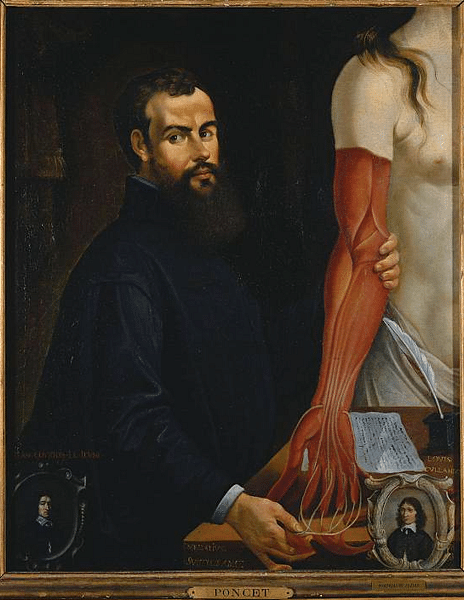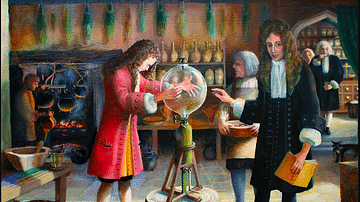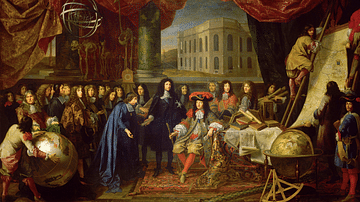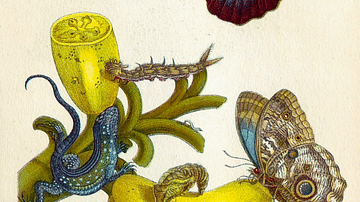
Andreas Vesalius (1514-1564) was the most celebrated anatomist in Europe during the 16th century and a key figure of the Scientific Revolution. Vesalius' great work was his On the Fabric of the Human Body, which contains over 250 remarkable anatomical illustrations. Vesalius' investigations corrected many long-held errors in anatomy and helped change attitudes so that it became as important as any other in the field of medicine.
Early Studies
Andreas Vesalius was born in the province of Brabant in Flanders in December 1514 into a family already noted for its endeavours in the field of medicine. Andreas' father was the apothecary of Charles V, Holy Roman Emperor (r. 1519-1556). Andreas studied at the University of Louvain in Belgium and then moved to Paris, where he studied medicine at the university there, then a renowned centre of learning in that subject. Vesalius was a contributor to a Latin volume on the work of the most celebrated physician of antiquity, the Greek Galen (129-216 CE). Hopping around Europe, Vesalius next studied at the University of Padua in northern Italy, another key centre of learning in medicine. Vesalius qualified as a doctor in Padua in 1537. He stayed on at the university and became a lecturer in surgery and anatomy, presumably his skill at anatomy had already displayed itself since this position was specifically created for Vesalius.
At universities, anatomy and surgery still remained less prestigious subjects of inquiry than medicine, the former being regarded as more akin to crafts while the latter was more highly regarded as a theoretical and purely intellectual pursuit of knowledge. It is significant that anatomists were never given positions as heads of university faculties. Vesalius and other anatomists like him were determined, though, to demonstrate anatomy's importance and that a careful observation of the body could greatly increase the knowledge base of medicine as a whole, as the historian J. Henry here explains:
Significantly, Vesalius and other Renaissance anatomists saw themselves not as philosophical interpreters of nature but as simple observers – dependent only on autopsia or 'seeing for oneself' to demonstrate the structures and functions of bodies.
(41)
The Impact of On the Fabric of the Human Body
Vesalius' first major published work in the field of anatomy was 6 Tabulae anatomiae, a collection of six anatomical charts, published in 1538. Five years later, in 1543, Vesalius took the academic world by storm with his De humani corporis fabrica (On the Fabric of the Human Body). This book provided the most comprehensive and detailed study of human anatomy yet produced. There was nothing particularly new about the information in the book, but the approach was totally different. First, the many spectacular drawings it contained caused a sensation. Vesalius had been inspired by contemporary illustrated books on botany, and he wanted the same sort of approach for his anatomical illustrations. He also wanted the illustrations precisely labelled (often using letters and a key) so that the reader could better understand his text. In all, there were some 250 wood-cut illustrations.
Vesalius was canny enough to commission the very best for his anatomical illustrations, deciding to use artists from a Venetian workshop with ties to no less a figure than Titian (c. 1487-1576). Many illustrations were drawn by the German artist Jan Steven van Calcar (1499 to c. 1550), who was residing in Venice at the time (he is sometimes known as Giovanni Fiammingo). The illustrations of full human figures were particularly striking because van Calcar had chosen to present them in active, life-like poses with realistic gestures; there are even some that trouble the mind since they look distinctly like the figure is feeling the agony of death or, even worse, of dissection. Unable to resist the artistic trends of the times, many of the diagrams have the architectural ruins so loved by Renaissance artists in the background, although one could take these as a deliberate metaphor for the crumbling of the knowledge of antiquity as the wonders of modern science now take centre stage. On seeing van Calcar's illustrations, the celebrated historian of Renaissance art Giorgio Vasari (1511-1574) noted, perhaps not inaccurately because we are still talking about them 500 years later, that they "must do him honour for all time" (Rundle, 73).

Vesalius was also very particular about the printing process for his great work, and he travelled to Basel, then a renowned centre of printing, to personally meet his printer, Johannes Oporinus. The effort was worth it since the book was so popular that it was reprinted several times, and a revised edition was published in 1555. A mark of the book's enduring appeal is the fact that it was plagiarised by Thomas Geminus in England in 1555. The book's original illustrations took on a life of their own and were independently printed for use in lecture halls and private study. There were even cut-out versions of the illustrations where students could be asked to replace different organs in their correct position.
The second unique selling point of On the Fabric of the Human Body was that Vesalius dealt with human anatomy systematically from the very inside and then moved to the outside, starting with the skeleton and ending with the skin. Most medieval texts had been rather random in their presentation and followed the dissector's knife, starting with the skin and then working through whatever they came across in their investigations. Another advantage was Vesalius' particular approach to anatomy. Medieval anatomists often adhered rigidly to ancient medical texts, but these had been written by Galen and others when human dissection had been forbidden, and so many of their ideas were based on observations in the anatomy of other animals, the hope being humans were similar.

Anatomy & the Scientific Revolution
Another weakness of previous anatomists, or at least medieval ones, was that they rarely got their hands dirty because they usually charged an assistant with the task of actually cutting into bodies. Vesalius did the dissection work himself, even in his lectures, which were very well attended as a consequence. A result of this hands-on approach was that, because Vesalius knew what he was looking for and what he was looking at, he was able to correct some long-held errors, such as that the wall separating the ventricles of the heart is perforated (it is not), that the liver has five lobes (it has none), and that women have one less rib than men (they have the same number).
Vesalius' work put the efforts of the ancient anatomists, especially Galen, under as serious scrutiny as the bodies he was dissecting, and so much of their work was now shown to be incorrect. Henry notes that Vesalius found over 200 errors in Galen's work.

The Scientific Revolution (1500-1700) questioned many ideas which had held sway since antiquity, and so anatomy, as pioneered by Vesalius, was an important part of this overturning of the medieval obsession with revering ancient thinkers without questioning their essential precepts. Here was the great change. Instead of trying to prove the ancients were correct, early modern scientists were now attempting to conduct experiments without any prejudgement as to what the actual findings might be.
Vesalius' Legacy
On the Fabric of the Human Body became a standard textbook in universities for its illustrations, descriptions of human anatomy, notes on how to successfully conduct specific types of dissection, and useful illustrations of the dissection tools required. That the work was highly esteemed by other intellectuals and those in the medical profession is illustrated by the fact that several of the 16th-century's prominent physicians, for example, Girolamo Mercuriale (1530-1606), had their portraits painted clutching a copy of Vesalius' book of anatomy decades after the work was first published.
The immensely detailed and well-labelled illustrations of On The Fabric of the Human Body became a vital point of reference for later anatomists and allowed them to make corrections as new anatomical discoveries were made. As the historian D. Wootton puts it: "In anatomy, discovery does not begin with Vesalius: rather, he provides the baseline that allows others to claim to have made discoveries" (184).

Vesalius left Padua in 1543. In 1555, following in his father's footsteps, he took up the position of household physician at the court of the Holy Roman Emperor, in this case Philip II of Spain. The famed anatomist died in June 1564 when his ship met a storm and was shipwrecked on the voyage back from a pilgrimage to Jerusalem. Anatomical research continued and moved away from a preoccupation with structure – understandable now that Vesalius had shown what was where – and instead focussed more on function. This new approach led to significant new findings in the field of anatomy, such as William Harvey's discovery of blood circulation in 1628. There was also an improvement in the status of anatomy compared to medicine in universities, something which Vesalius had always pushed for and which he had lamented in the preface to his great monument of knowledge, On the Fabric of the Human Body.
In the study of the history of science, 1543 was once considered to be the birth of modern science since not only was Vesalius' influential work published that year but also Nicolas Copernicus' revolutionary book on astronomy De revolutionibus orbium coelestium (On the Revolutions of the Heavenly Spheres). The view that science (or any other movement) begins at a specific time is now not widely endorsed by historians, but this traditional date does still illustrate the importance of Vesalius' work: "Copernicus and Vesalius demonstrated how a new appreciation of ancient learning – a rebirth or, as we would now say, a 'renaissance' – could indeed change the fundamental shape of knowledge" (Campbell, 415).






